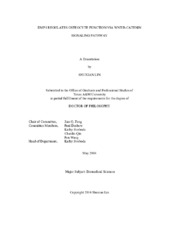| dc.description.abstract | DMP1, dentin matrix protein 1, was cloned from a rat dentin cDNA library 20
years ago. Initially, this non-collagenous matrix protein was thought to be dentin specific
and gained little interest in other scientific communities except the dental research area.
Research that identified DMP1 mutations in humans and deletion in mice lead to the
discovery of a novel disease: autosomal recessive hypophosphatemic rickets
(ARHR). Functional studies reveal that DMP1 is essential for the maturation and
functions of osteoblast and osteocyte via two possible mechanisms: 1) as a transcriptional
factor that directly regulates osteo-/odonto-specific genes; and 2) as an extracellular
matrix (ECM) protein, which controls bone and dentin mineralization. However, both
theories appear controversy. Besides, the mechanism by which ARHR patients or Dmp1-
null mice develop osteomalacia is largely unknown.
In this study, we initially targeted DMP1 either in the nucleus only by replacing
the endogenous signal peptide with the NLS signal peptide (named ^(NLS)DMP1), or
targeted it in the ECM by using its own signal secretive peptide with the same
recombinant DMP1 protein (named ^(SP)DMP1). The ^(NLS)DMP1 transgene, when expressed
in the Dmp1-null osteoblast and osteocyte in vivo, failed to rescue the Dmp1-null
phenotype, whereas the ^(SP)DMP1 transgene fully rescued the skeletal abnormalities of
Dmp1-null mice, indicating that DMP1 functions as an ECM protein in vivo.
In a separate research, we revealed an elevated β-catenin expression level in
Dmp1-KO osteocytes, besides, the targeted expression of β-catenin in the osteocyte
recaptured the osteomalacia phenotype, similar to that in Dmp1-KO mice. Furthermore,
the targeted expression of DKK1 (a potent inhibitor of Wnt/β-catenin) in Dmp1-KO
osteoblasts by crossing Dmp1-KO and 2.3 Col 1-Dkk1 mice, resulting in consequent
blockade of Wnt/β-catenin signaling, significantly improved the rachitic/osteomalacic
phenotype. The results of this study will expand our understanding of how the osteocytes
regulate bone development and mineralization during the early postnatal period. In
addition, this study has clinical relevance, as a high Pi diet alone fails to fully restore the osteomalacic status in patients, and normalizing the Wnt/β-catenin signaling may benefit
these patients. | en |


